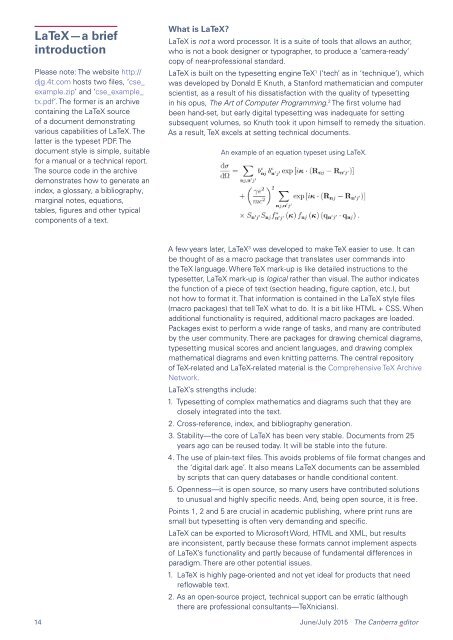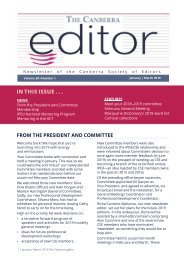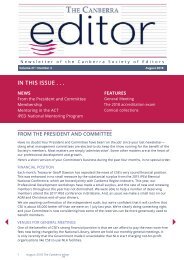The Canberra editor June-July 2015
Newsletter of the Canberra Society of Editors
Newsletter of the Canberra Society of Editors
Create successful ePaper yourself
Turn your PDF publications into a flip-book with our unique Google optimized e-Paper software.
LaTeX—a brief<br />
introduction<br />
Please note: <strong>The</strong> website http://<br />
djg.4t.com hosts two files, ‘cse_<br />
example.zip’ and ‘cse_example_<br />
tx.pdf’. <strong>The</strong> former is an archive<br />
containing the LaTeX source<br />
of a document demonstrating<br />
various capabilities of LaTeX. <strong>The</strong><br />
latter is the typeset PDF. <strong>The</strong><br />
document style is simple, suitable<br />
for a manual or a technical report.<br />
<strong>The</strong> source code in the archive<br />
demonstrates how to generate an<br />
index, a glossary, a bibliography,<br />
marginal notes, equations,<br />
tables, figures and other typical<br />
components of a text.<br />
What is LaTeX?<br />
LaTeX is not a word processor. It is a suite of tools that allows an author,<br />
who is not a book designer or typographer, to produce a ‘camera-ready’<br />
copy of near-professional standard.<br />
LaTeX is built on the typesetting engine TeX 1 (‘tech’ as in ‘technique’), which<br />
was developed by Donald E Knuth, a Stanford mathematician and computer<br />
scientist, as a result of his dissatisfaction with the quality of typesetting<br />
in his opus, <strong>The</strong> Art of Computer Programming. 2 <strong>The</strong> first volume had<br />
been hand-set, but early digital typesetting was inadequate for setting<br />
subsequent volumes, so Knuth took it upon himself to remedy the situation.<br />
As a result, TeX excels at setting technical documents.<br />
An example of an equation typeset using LaTeX.<br />
A few years later, LaTeX 3 was developed to make TeX easier to use. It can<br />
be thought of as a macro package that translates user commands into<br />
the TeX language. Where TeX mark-up is like detailed instructions to the<br />
typesetter, LaTeX mark-up is logical rather than visual. <strong>The</strong> author indicates<br />
the function of a piece of text (section heading, figure caption, etc.), but<br />
not how to format it. That information is contained in the LaTeX style files<br />
(macro packages) that tell TeX what to do. It is a bit like HTML + CSS. When<br />
additional functionality is required, additional macro packages are loaded.<br />
Packages exist to perform a wide range of tasks, and many are contributed<br />
by the user community. <strong>The</strong>re are packages for drawing chemical diagrams,<br />
typesetting musical scores and ancient languages, and drawing complex<br />
mathematical diagrams and even knitting patterns. <strong>The</strong> central repository<br />
of TeX-related and LaTeX-related material is the Comprehensive TeX Archive<br />
Network.<br />
LaTeX’s strengths include:<br />
1. Typesetting of complex mathematics and diagrams such that they are<br />
closely integrated into the text.<br />
2. Cross-reference, index, and bibliography generation.<br />
3. Stability—the core of LaTeX has been very stable. Documents from 25<br />
years ago can be reused today. It will be stable into the future.<br />
4. <strong>The</strong> use of plain-text files. This avoids problems of file format changes and<br />
the ‘digital dark age’. It also means LaTeX documents can be assembled<br />
by scripts that can query databases or handle conditional content.<br />
5. Openness—it is open source, so many users have contributed solutions<br />
to unusual and highly specific needs. And, being open source, it is free.<br />
Points 1, 2 and 5 are crucial in academic publishing, where print runs are<br />
small but typesetting is often very demanding and specific.<br />
LaTeX can be exported to Microsoft Word, HTML and XML, but results<br />
are inconsistent, partly because these formats cannot implement aspects<br />
of LaTeX’s functionality and partly because of fundamental differences in<br />
paradigm. <strong>The</strong>re are other potential issues.<br />
1. LaTeX is highly page-oriented and not yet ideal for products that need<br />
reflowable text.<br />
2. As an open-source project, technical support can be erratic (although<br />
there are professional consultants—TeXnicians).<br />
14 <strong>June</strong>/<strong>July</strong> <strong>2015</strong> <strong>The</strong> <strong>Canberra</strong> <strong>editor</strong>

















